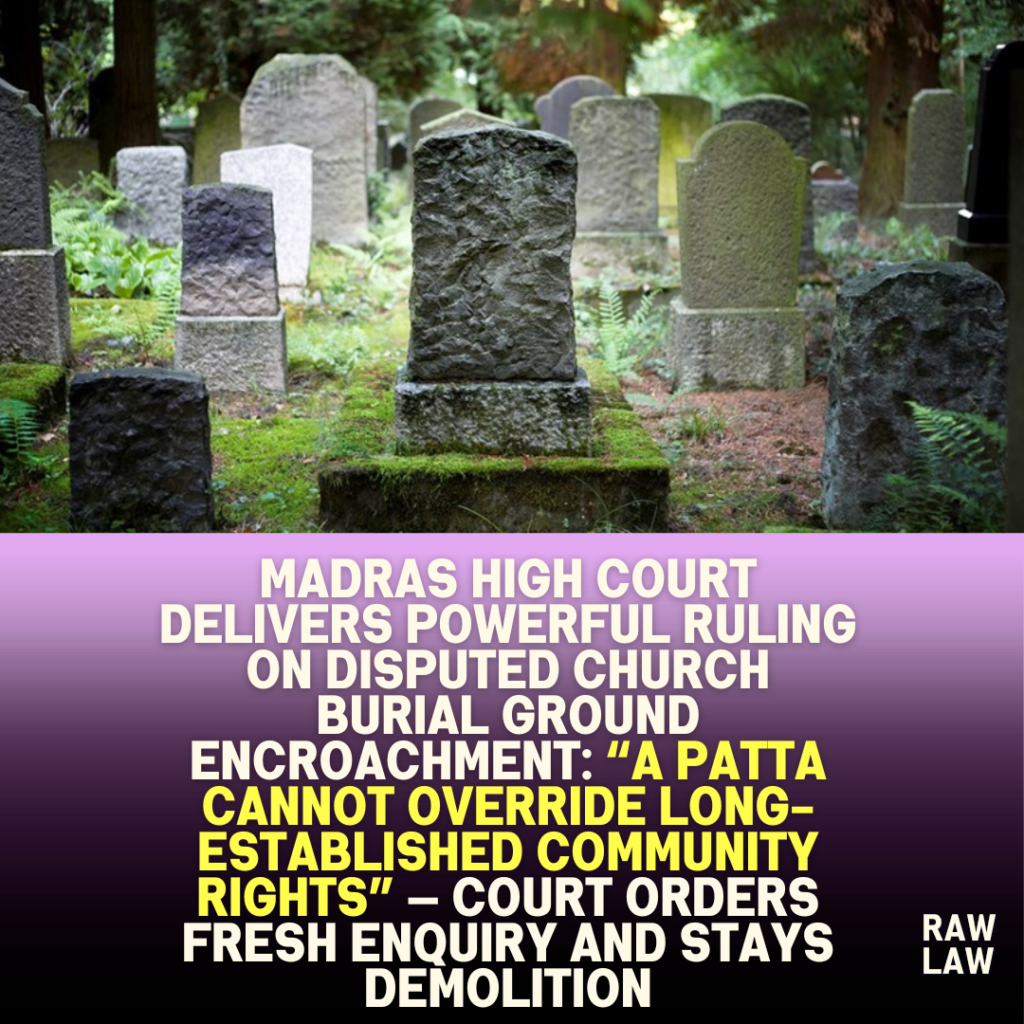Court’s decision
The Madras High Court quashed the impugned order directing removal of alleged encroachment over land claimed as a church burial ground and remitted the matter for fresh enquiry. The Court held that the authorities acted without properly examining historical documents, revenue records, or community use patterns. Emphasising that “a patta is not conclusive when long-standing communal enjoyment is established,” the Court directed the officials to conduct a comprehensive survey, hear all stakeholders including the Christian community, and determine the true character of the land. Pending such reconsideration, the Court restrained coercive action and ordered maintenance of status quo.
Facts
The petitioner, a developer, claimed ownership over a parcel of land based on patta and sale deeds. The local authorities, however, issued a notice alleging that a portion of the land formed part of a traditional church burial ground used by the Christian community for decades. Acting on the objection filed by church representatives, the authorities directed removal of structures said to constitute encroachments. The petitioner filed documents asserting lawful title and contending that the lands form part of an approved layout. The authorities allegedly failed to provide detailed reasons or undertake proper measurement. The petitioner approached the Madras High Court seeking quashing of the removal order.
Issues
The Court identified critical issues:
- Whether the land is part of a historically used church burial ground.
- Whether a patta and registered documents conclusively establish title against longstanding communal usage.
- Whether officials conducted a lawful and fair enquiry before passing demolition orders.
- Whether revenue authorities can direct removal without verifying factual records and hearing affected parties.
- Whether principles of natural justice were followed.
Petitioner’s arguments
The petitioner argued that the disputed land is private property supported by valid title documents, including patta and parent deeds. He claimed that the authorities issued an eviction/demolition notice without proper survey or measurement and without examining layout approvals granted earlier. He contended that community objections were unfounded and had surfaced only after development began. According to him, no burial ground is reflected in revenue records, and the officials acted on mere assumptions and community pressure. He alleged violation of natural justice because no meaningful opportunity was provided before passing the impugned order.
Respondent’s arguments
The respondents, including the revenue authorities and church representatives, submitted that the land had been used as a burial ground by the Christian community for many decades, and documentary evidence existed to support such usage. They argued that the petitioner’s pattas cannot defeat communal burial rights established through long-standing practice. They contended that the petitioner had attempted to encroach upon sensitive community land and that urgent steps were needed to preserve the burial ground. The authorities argued that under revenue laws, they are empowered to remove encroachments over common property and that procedural requirements had been satisfied.
Analysis of the law
The Madras High Court examined legal principles governing title, community rights, and burial grounds. It reiterated that pattas are evidence of possession but not conclusive of title, especially when the land involves communal usage. The Court emphasised that under revenue jurisprudence, land that has been continuously used as a burial ground acquires a distinct legal character. Authorities must therefore conduct a thorough factual enquiry, examine historical records, survey maps, field measurement books, community certificates, and documentary evidence before concluding encroachment. The Court stated that summary orders without comprehensive evaluation violate natural justice and undermine the statutory framework governing communal land.
Precedent analysis
The Court referred to established precedents holding that burial grounds constitute community property, and their character cannot be altered merely through mutation entries. Earlier rulings have emphasised that pattas confer only limited evidentiary value and cannot extinguish communal rights proven by usage. The Court relied on judgments stressing that authorities must hold detailed enquiries, including on-ground inspection, before ordering eviction from alleged communal land. These precedents guided the Court in remanding the matter for proper examination.
Court’s reasoning
The Court found that the authorities had not conducted a detailed survey or produced foundational documents proving the character of the land as a burial ground. The impugned order lacked reasoning, failed to specify measurement details, and did not analyse the petitioner’s title records. It noted that when a dispute concerns communal burial land, the enquiry must be careful, transparent, and sensitive to both documentary title and community usage. The Court observed that the authorities relied heavily on representations without verifying records, thereby violating natural justice. Such deficiencies warranted judicial intervention and remand.
Conclusion
The Madras High Court quashed the impugned removal order and directed the authorities to:
– Conduct a full enquiry with survey, inspection, and verification of historical records.
– Provide opportunity to the petitioner and church representatives to submit evidence.
– Determine the land’s true character by applying statutory principles.
– Maintain status quo until completion of the enquiry.
The Court emphasised that sensitive disputes involving burial grounds cannot be resolved summarily and require reasoned, evidence-based decision-making.
Implications
This ruling strengthens procedural safeguards in disputes involving communal land, especially burial grounds. It clarifies that pattas and title deeds do not automatically negate longstanding community usage. Authorities must undertake comprehensive fact-finding before ordering demolition. The judgment also signals judicial sensitivity to religious and communal rights, while ensuring that development activities are scrutinised in accordance with law. The ruling will influence future disputes between private developers and religious communities, particularly in cases involving historical burial grounds.
